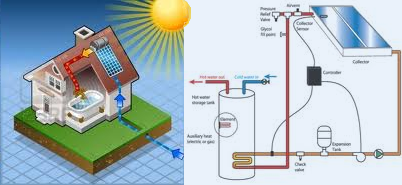CERCOPES (Low Temperature Solar Collector Certification) is an information system to allow the certification of low temperature solar collectors and its families under the law in force in Spain, the IET/401/2012 Order. It eases the relationship between the public administration and the private sector, allowing solar collectors certification to be requested and processed completely by electronic means, reducing the required documentation and the administrative and economic burdens.

Thus, CERCOPES main objectives are:
- The simplification and computerized management of the entire lifecycle of the certification, from the request to the processing of the certification of low temperature solar collectors,
- The reduction of the administrative burden required to certificate solar systems, by regulating the concept of family of solar systems and establishing a new framework for the testing as Standard EN-12976, in order to certification, as was previously done for the solar collectors in 2007.
- The alignment with the European Union. The Order ITC/71/2007 upgrades the quality standard applicable to solar collectors, regulating the conditions for prefabricated solar systems and defines the conditions to be met by accredited laboratories and certification bodies in this area.
- The decrease of the costs associated with the certification of families of low temperature solar systems. It has a significant economic impact for companies selling low-temperature solar systems, who now only need to prove the laboratory tests for the most representative system of the family (a laboratory test for a model may be around 6,000€). Before, it was necessary to prove each one of the systems, multiplying the cost of the certification by the number of collectors in each system. Thus, the application CERCOPES improves the lives of citizens and businesses allowing families requesting certifications electronically providing only documentation of the most representative of the family model.
CERCOPES has a significant impact on the following groups:
- Companies in the sector of renewable energies, in particular manufacturers of products for the production of solar energy, which will benefit from a reduction in the requirements, both financial and administrative, to certify families or solar collectors.
- Citizens, who benefit from the production and certification of solar collector, because the installation of these collectors in their homes can generate savings on the electricity bill.
Finally, CERCOPES aligns with the European Digital Agenda:
- Improving the quality of life of citizens and businesses allowing the complete processing of the certificates without the need for transport and paper usage.
- Because it stimulates job creation. The reduction of the costs of using solar thermal technology increases the demand for it, so more jobs are needed to meet the increased consumption of this type of technology (manufacturers, installers, traders, etc).
- Because it promotes the growth of companies in the solar industry, as it adapts to the new regulation, allowing an optional cost reduction by enabling certification for system.
Policy Context
Certification of low temperature solar collectors in our country began in 1980, as a technological response to the first oil crisis. The Spanish National Institute for Aerospace Technology (INTA) developed their own standards for testing solar collectors.
The Renewable Energy Plan in Spain (2005-2010), adopted on August 26th in 2005, was a strong impetus to the development of low-temperature solar energy, mainly for the production of hot water. The solar thermal sector in Spain had in 2010 2,366,534 m2 (1,657 MW), which produced 183 kTep (2128 GWh). The sector, by 2010, was formed by over 100 companies, 40 of which are manufacturers of collectors and equipment. In the upcoming years, a drop in costs is expected due to significant improvements in manufacturing and the scale effect (higher manufacturing sites). As for the existent types of installations, it is expected to extend the penetration in different sectors beyond the residential sector, for instance, the service sector or industry, with large or medium size installations, which provide thermal energy for use in ACS, HVAC (heating, ventilation and air conditioning) and industry.
Given the boom in renewable energy and in order to facilitate certification of solar collectors and systems the regulation was adapted in 2007, typifying the family of collectors concept by the ITC/71/2007 Order of January 22th, which establishes the possibility for the solar collectors belonging to the same family, to be required, towards their certification tests stipulated in EN-12975, only a smaller sample size and a larger size of these sensors, defining what tests should be performed at each.
The concept of system families was joined by IET/401/2012 Order of 28 of February, amending the Annex to the Order of July 28, 1980, which approved the rules of technical instructions complementary to the approval of solar panel. It provides a framework for the testing requirement, as per EN-12976 corresponding to solar systems towards their certification.
Description of target users and groups
CERCOPES has a significant impact on the following groups:
- Companies in the sector of renewable energies, in particular manufacturers of products for the production of solar energy, which will benefit from a reduction in the requirements, financial and administrative, to certify families or solar collectors.
- Citizens, who benefit from the production and certification of solar collectors, because the installation of these collectors in their homes can generate savings on the electricity.
Description of the way to implement the initiative
First of all, a study in the register entries of the Ministry was carried out; the result was that a great amount of the paper entries were applications for the certification of collectors and low temperature solar panel systems. Therefore, the development of the information system was approached in two phases. The first one dealt with the application forms and its internal processing. In a second phase, the system was adapted to the new regulation (Order IET/401/2012) that allows a significant reduction and cost savings for businesses.
Thus, the application consists of the following subsystems:
- The reporting subsystem. The companies may submit applications for certification, renewal and change of name for low temperature solar collectors using different web forms. It includes a section where the needed files in each case can be attached. An automatic receipt of the electronic application submission is generated for the user.
- The file management subsystem associated with each collector certification. It stores all the incoming information from applications, collectors, certifications and registered companies to facilitate searches, reports and, especially, information exploitation.
- The generation of administrative resolutions subsystem. It automatically generates the administrative resolutions according to the model needed in each step of the certification lifecycle.
In order to encourage the reuse of resources and capabilities, translating this into a reduction of the spending software development projects, CERCOPES has benefited from the common software resources within the ministry. Some of these are:
- Electronic Registry of the Ministry of Industry, Energy and Tourism, that records the input and output information for the citizens.
- BPM (Business Process Management), in order to manage the flow followed by the whole application. The use of BPM is a clear advantage it provides in relation to the management and maintenance of procedural flow.
- Automatic communication with citizens or business through business process definition (BPM) and integration with Electronic Registry.
- Identity Certificates Validation System. To ensure the identity of citizens who communicate with the application.
- Module for automatic translation and language management. To facilitate the task of translation and manipulation of language in the application.
This reutilization model can be accomplished by using a service-oriented architecture. Web services are used as a communication tool with other applications or services, which allows a platform independent client-server communication.bill.
Technology solution
The following technologies have been used:
- Database: it is SQL Server 2005, stored procedures have been developed, as well as tables and views needed to exploit the information. The information received and recorded in the database can be further exploited using the reports section of the application or by consulting the database itself.
- Communication with other services: the application will communicate with the web services of the electronic registry and the common repository.
- Technology: the system is developed in C # and ASP.NET, deployed in an IIS 6.0 Web server. And it is compliant with W3C validations for CSS and XHTML 1.0.
- Multilinguism: it supports plus several communitarian languages in addition to Spanish: English, French and German.
Main results, benefits and impacts
Within the strategic plans of administrative simplification in the Ministry, priority has been given to the project CERCOPES because of the efficiency improvements and cost reductions it introduces in the renewable energies sector.
With the implementation and launch of CERCOPES system, the processing of flat solar collectors certification has been streamlined and companies are experiencing significant savings of the money required to meet the certification requirements in families of low temperature solar collectors, which can be considered a key factor in the economic context we find nowadays. It is estimated that businesses benefit from a 75 euros cost reduction per electronic request compared to its equivalent in paper. Besides, for every request that is made for a family of collectors with 8 collector average, reduction is estimated in 36.000 € per request, as only one laboratory test is required for the representative model of the family. Also, the costs associated to the processing of the certification requests have been reduced, generating important savings to the Ministry. This savings are produced because fewer employees are needed to process certifications.
CERCOPES project also promotes the use of renewable energies in our country, providing companies an electronic mean to certify low temperature solar collectors. According to the Spanish Technical Building Code, all new buildings have to install solar panels for hot water heating. And, according to the data provided by the former Ministry of Housing, the extra cost in construction is near 1 per cent, but it is completely recovered in long term. It is estimated that the use of solar panels can generate savings of between 75 and 150 euros annually. Thus, in the current economic crisis in which we are immersed, the savings in electricity bills may have a greater impact in economically disadvantaged neighbourhoods. It is hoped that the solar power that is generated by solar collectors will help lower energy costs, thus providing assistance where it is needed most.
Finally, there are some initiatives that combine synergies with the project. The plan of the Spanish Strategy for Science and Technology Innovation mentions the EU-SOLARIS initiative adopted by the European Strategy Forum on Research Infrastructures (ESFRI) and was classified of pan-European interest. Through this initiative, an infrastructure will be built, headquartered in Tabernas (Almería), whose goal is the development of science and technology of concentrating solar energy systems. This investment will undoubtedly result in improved performance and efficiency of the technology used in low temperature solar collectors and internationalization and technology diffusion.
Lessons learnt
- The modernization, rationalization and simplification of administrative procedures facilitates the relationship between citizens and the administration, helping to reduce the administrative costs of business activities and helps to improve business competitiveness and stimulate their development, hence it is necessary to concentrate on the reduction of paperwork and red tape, all in a collaborative framework between the different public administrations.
- Innovation in technology can be one of the best allies to optimize resources and increase productivity in administrative processing. The BPMN flow system has been a key factor to reduce costs in CERCOPES and in future projects.


Comments
Very intresting Post!! It is hard to find vualuable information about this topic. Panel solar is usually hard to install but thanks to this, I think I´ll be able to do it by my own. Thanks!!